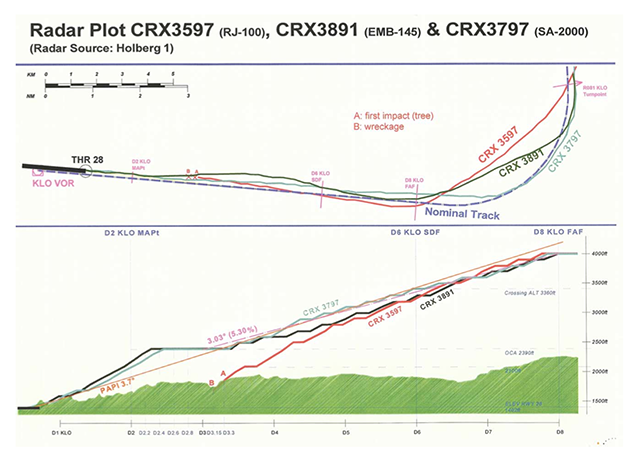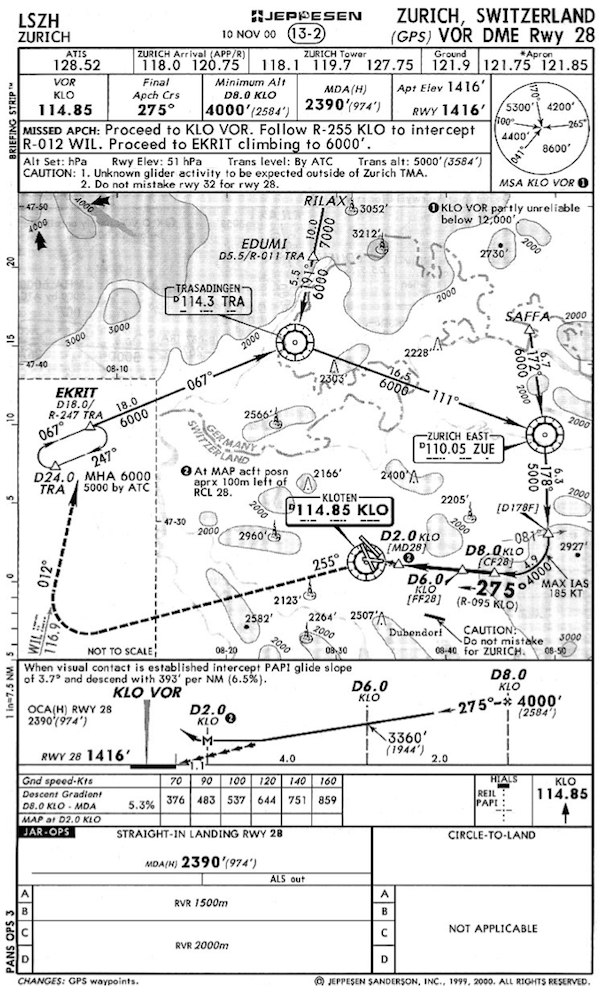This crash would have been prevented had the crew properly flown the approach. They would have been aided in this effort had they computed a visual descent point. More about this: Visual Descent Point. An even better technique is available today: Continuous Descent Final Approach (CDFA). Though this mishap was in 2001, the aircraft and crew had all they needed to fly a CDFA back then.
— James Albright
1
Accident report
- Date: 24 November 2001
- Time: 22:06
- Type: Avro RJ.100
- Operator: Crossair
- Registration: HB-IXM
- Fatalities: 3 of 5 crew, 21 of 28 passengers
- Aircraft Fate: Damaged beyond repair
- Phase: Approach
- Airports: (Departure) Berlin-Tegel Airport, (TXL / EDDT), Germany; (Destination) Zurich-Kloten Airport, AB (ZRH / LSZH), Switzerland
2
Narrative
- On 24 November 2001 at 20:01 UTC the aircraft AVRO 146 RJ 100, registered as HB-IXM of the Crossair airline company took off in darkness from runway 26L at Berlin-Tegel airport as scheduled flight CRX 3597 to Zurich.
- At 20:58:50 UTC, after an uneventful flight, the aircraft received the clearance for a standard VOR/DME approach 28 at Zurich airport.
- Ahead of the aircraft involved in the accident, an Embraer EMB 145, flight CRX 3891, landed on runway 28 at Zurich airport. The crew informed the control tower that the weather was close to the minimum for this runway.
Source: Swiss Final Report 1793, page 11.
They also noted they were just outside of 2 nm from the runway when they spotted the runway.
At 21:05:21 UTC flight CRX 3597 reported on the aerodrome control frequency. When the aircraft reached the minimum descent altitude (MDA) of 2390 ft QNH at 21:06:10, the commander mentioned to the copilot that he had certain visual ground contact and continued the descent.
Source: Swiss Final Report 1793, page 11.
At this point he was nearly 6 nm from the runway and 4 nm away from what would have been a normal descent point.
- As the aircraft approached the minimum descent altitude (MDA) for the approach, the commander mentioned at 21:05:55 UTC that he had noted this and explained that he had certain visual ground contact: "Zwei vier, ground contact hämmer, hä" – Two four (2400), we have ground contact". The copilot answered: "Yes". At 21:05:59 UTC the commander stated: "Mä hät gseit, Pischte hät er spaht gseh da... approaching mini- mum descent altitude... da hämmer ächli ground contact..." – Someone said he saw the runway late here ... approaching minimum descent altitude... here we've got some ground contact.
- At 21:06:10 UTC the aircraft reached the MDA of 2390 ft QNH and the commander said: "...zwo vier, s'Minimum... ground contact han ich... mer gönd wiiter im Moment... es chunnt füre, ground contact hämer... mer gönd wiiter..." - ...two four (2400), the minimum ... I have ground contact ... we're continuing at the moment ... it appears, we have ground contact ... we're continuing on ... .
Source: Swiss Final Report 1793, page 19.
There is no mention of seeing the runway at this point.
At the same time, the copilot said quietly to himself: "Two four". The descent continued unchanged below the MDA. At 21:06:22 UTC the synthetic voice of the ground proximity warning system (GPWS) announced the radio altimeter reading 500 feet above ground. Immediately thereafter, the commander stated: "*****, zwee Meile hät er gseit, gseht er d'Pischte" – *****, two miles he said, he sees the runway.
Source: Swiss Final Report 1793, page 19.
When the captain spotted the runway he was 4.5 nm away and around 2,000 feet, just 600 feet above runway elevation and much less than that over the terrain.
At 21:06:31 UTC the commander mentioned that 2000 feet had been reached: "Two thousand". In addition, one second later the synthetic voice gave the "minimums" GPWS message, which was triggered by the radio altimeter reading at 300 feet. At 21:06:32 UTC aerodrome control ADC 1 gave flight CRX 3597 the landing clearance. During this radio conversation, the commander said quietly: "...go around mache?" – ...make a go around? At 21:06:34 UTC the commander instructed a go around and an acoustic signal indicated that the autopilot had been switched off. A few fractions of a second later, the copilot likewise expressed the intention to go around. The recordings of the digital flight data recorder prove that the crew pushed the power levers towards the take-off thrust position and the engines' RPM increased. One second later, the CVR began to record the sounds of an impact. A short time later, the CVR recording broke off.
Source: Swiss Final Report 1793, page 19.
- At 21:06:36 UTC the aircraft collided with treetops and subsequently crashed into the ground.
- The aircraft caught fire on impact. Twenty-one passengers and three crew members died from their injuries at the site of the accident; seven passengers and two crew members survived the accident.
Source: Swiss Final Report 1793, page 11.
3
Analysis
There are a lot of problems to consider:
- The approach had been improperly designed and it would have been nearly impossible to spot the runway from the MDA at the PAPI angle given the weather, which was well above the published minimums.
- The captain had a history of undisciplined flying and poor cockpit resource management skills.
- This airline's culture, at the time, discouraged first officers from correcting their captains.
But all of that could have been overcome had the captain simply stayed at the non-precision approach's MDA until a good visual descent point or when on the PAPI glide slope. The captain decided to begin his descent upon first sight of the ground; it does not appear that he saw the runway, which was obscured by a patchy layer of clouds.
4
Cause
- The investigation has determined the following causal factors in relation to the accident:
- The commander deliberately descended below the minimum descent altitude (MDA) of the standard VOR/DME approach 28 without having the required visual contact to the approach lights or the runway
- The copilot made no attempt to prevent the continuation of the flight below the minimum descent altitude.
- The following factors contributed to the accident:
- In the approach sector of runway 28 at Zurich airport there was no system avail- able which triggers an alarm if a minimum safe altitude is violated (minimum safe altitude warning – MSAW).
- Over a long period of time, the responsible persons of the airline did not make correct assessments of the commander's flying performance. Where weaknesses were perceptible, they did not take appropriate measures.
- The commander's ability to concentrate and take appropriate decisions as well as his ability to analyse complex processes were adversely affected by fatigue.
- Task-sharing between the flight crew during the approach was not appropriate and did not correspond to the required procedures by the airline.
- The range of hills which the aircraft came into contact with was not marked on the approach chart used by the flight crew.
- The means of determining the meteorological visibility at the airport was not representative for the approach sector runway 28, because it did not correspond to the actual visibility.
- The valid visual minimums at the time of the accident were inappropriate for a decision to use the standard VOR/DME approach 28.
Source: Final Report, page 12.
The intersection point of the PAPI glide path (3.7°) with the minimum descent altitude was at a slant distance of 3.3 NM from VOR/DME KLO, or 2.4 NM (4.4 km) ahead of the runway threshold. In order to be able to see the approach lights from this point, a computed minimum visibility of 3700 m would be necessary.
Source: Final Report 1793, page 123.
The reported visibility was 3500 meters, more than what they needed on the approach plate but not enough for what they needed doing the math. Had the crew stayed at the MDA it is unlikely they would have seen the runway at the last reported visibility of 3,500 m. But it was patchy and it is possible. In either case, go around or land, the mishap could have been avoided had the captain simply followed basic instrument flying procedure.
References
(Source material)
Swiss Confederation Final Report No. 1793 by the Aircraft Accident Investigation Bureau, Concerning the accident to the aircraft AVRO 146-RJ100, HB-IXM, Operated by Crossair under flight number CRX 3597, on 24 November 2001, near Bassersdorf/ZH.



